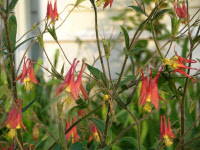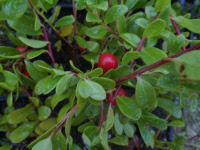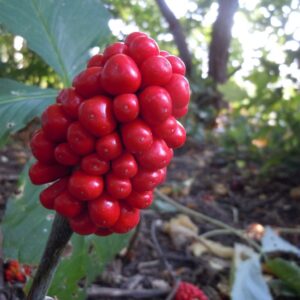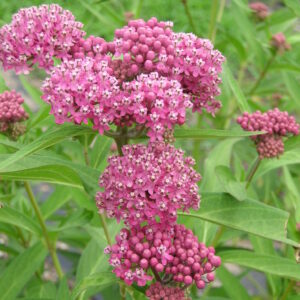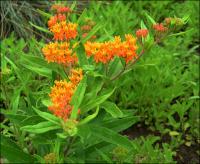Wisconsin Native
Showing 9–16 of 107 results
-
Aquilegia canadensis Canada Columbine Z 3-9
In May and June yellow petticoats peek out from under eye-popping red skirts flaring at the ends as these flowers dangle from tall stems.
In May and June yellow petticoats peek out from under eye-popping red skirts flaring at the ends as these flowers dangle from tall stems.
Size: 24-36”x 12”
Care: part shade in moist well-drained soil - moist in spring & dry in summer
Native: Eastern Canada to Florida, west to New Mexico, Wisconsin native.
Wildlife Value: Provides rich, early spring nectar for bumblebees, bees, butterflies, and hummingbirds. Buntings and finches eat seeds. Sole food source for Columbine duskywing caterpillar.
Awards: England’s Royal Horticultural Society Award of Merit.Seeds are fragrant when crushed, used by Omaha, Ponca and Pawnee as perfume. Pawnee used the plant as a love charm by rubbing pulverized seeds in palm of hand and endeavoring to shake hand of desired person. Crushed seeds also used to cure fever and headaches. Cherokee made a tea for heart trouble. The Iroquois used the plant to cure poisoning and to detect people who were bewitched. Grown by Tradescant the Elder in England in 1632. He may have received it from France. Cultivated by Washington & Jefferson. Grown at America’s 1st botanic garden, Elgin Botanic Garden 1811.
-
Arctostaphylos uva-ursi Bearberry, Bear’s grape, Kinnikinnick Z 2-7
In spring fragrant, pinkish-white bell-shaped flowers, evergreen, glossy foliage and Marlboro red berries in fall.
OUT OF STOCK
“Dwarf ornamental shrub, ornamental in foliage, flowers and berry.” Rand 1866. In spring fragrant, pinkish-white bell-shaped flowers, evergreen, glossy foliage and Marlboro red berries in fall. Great for cascading over edge of wall or groundcover.
Size: 4” x 20” forms dense groundcover over time. Stems root to spread.
Care: sun to part shade in moist well-drained to dry, acidic soil. Needs watering until established. Best grown with protection from wind.
Native: No. America, Wisconsin native
Wildlife Value: Host for several butterfly species including Hoary Elfin, Brown Elfin and Freija Fritillary.
Awards: Cary Award Distinctive Plants for New EnglandKinnikinnick is Algonquin meaning “mixture.” Used as an ingredient in Native American smoke mixtures. For centuries leaves used to make medicinal tea as a tonic and diuretic in many parts of the world. Cheyenne drank the tea to cure back sprains. Some Native Americans used it to cure venereal disease, others to cure pimples and itching, peeling skin. Both Indians and colonists mixed leaves with tobacco for smoking. Collected by Meriwether Lewis on the Expedition.
-
Arisaema dracontium syn. Arum dracontium Green dragon, Dragon root Z 4-9 POISON
A greenish, long-tipped spadix (the "dragon’s tongue") grows several inches beyond a narrow green spathe, a narrow, greenish, hooded, cylinder. Numerous tiny flowers crowd onto the 6-inch-long flower stem. Tiny white flowers in spring turn into a spike of red berries in fall.
OUT OF STOCK
A greenish, long-tipped spadix (the “dragon’s tongue”) grows several inches beyond a narrow green spathe, a narrow, greenish, hooded, cylinder. Numerous tiny flowers crowd onto the 6-inch-long flower stem. Tiny white flowers in spring turn into a spike of red berries in fall.
Size: 1-3’ x 6-8”
Care: part-shade to shade in moist, slightly acidic soil
Native: NH to Florida, west to TX, north to MN. Wisconsin native
Wildlife Value: Deer resistant. Although poison to humans, birds, wild turkeys and wood thrush as well as some mammals eat the berries.Named by 1753. Arisaema, is Greek for “blood arum” or “red arum”. Dracontium, means “of the dragon” in Latin. Named for the resemblance of the spadix to the tongue of a dragon. For the Menominee sacred bundles of the roots and gave the owner the power of supernatural dreams.
-
Arisaema triphyllum Jack-in-the-pulpit, Indian turnip Z 4-9
May-June striped, hooded spathe (leaf-like bract shielding one side of the upright spike), red berries in fall
OUT OF STOCK
May-June striped, hooded spathe (leaf-like bract shielding one side of the upright spike), red berries in fall – a favorite shade plant
Size: 6-24”x 12”
Care: Part shade - shade in moist soil
Native: Eastern No. America, Wisconsin native.Pawnee medicine men pulverized the corm to treat headaches and rheumatism. The Cherokee used it to cure headaches, the common cold, ringworm, boils and “for scald head (and) scrofulous sores.” Iroquois remedied adolescent diarrhea and listless infants with Jack-in-the-pulpit. Also “for nonconception caused by cold blood” and for “temporary sterility.” Chopped root mixed with whiskey cured colds. It induced pregnancy for female horses. Menominee pulverized the root, placed in incised lip to counteract witchery on the face. The seed predicted death or recovery for the Meskwaki who also used it as poison to kill enemies. The Potawatomi discovered that cooking the root for 3 days eliminated the poison. HoChunk spread a compound of the root on neuralgia or rheumatism. Native Americans boiled the berries and roasted the root, for food. Garden cultivation since 1664.
**LISTED AS OUT OF STOCK BECAUSE WE DO NOT SHIP THIS ITEM. IT IS AVAILABLE FOR PURCHASE AT OUR RETAIL LOCATION.
-
Artemisia frigida Prairie sagewort, Silky wormwood Z 3-10
Erect stems bear silvery-white, finely-divided foliage. Leaves smell like camphor. Inconspicuous yellow flowers bloom in summer.
OUT OF STOCK – EMAIL FOR AVAILABILITY
Erect stems bear silvery-white, finely-divided foliage. Leaves smell like camphor. Inconspicuous yellow flowers bloom in summer.
Size: 6-18” x 12-18”
Care: sun in well-drained soil. Drought tolerant.
Native: all North America except the SE, CA and OR, Wisconsin native
Wildlife Value: source of nesting material for native bees, food for caterpillars of several butterflies & moths
Awards: Royal Horticultural Society Award of Garden MeritNative Americans used this Artemisia to preserve meat, feed horses, repel insects, to remedy toothache, headache, coughing, lung ailments, heartburn, and colds. Indians in Great Basin used it in ceremonies. Chippewa made a decoction of root for convulsions. For the Lakota this was “women’s medicine” with an infusion helping regulate menstrual periods and induce contractions in pregnancy.
Meriwether Lewis collected this along the Missouri River in South Dakota on October 3, 1804. -
Asarum canadense syn. Hexastylis canadense Wild ginger Z 3-7
Concealed brown bell-shaped flowers with flared tips hide under this groundcover's crinkled, lacquered leaves.
Concealed brown bell-shaped flowers with flared tips hide under this groundcover’s lacquered leaves.
Size: 6" x 6" spreading
Care: part shade to shade, moist well-drained to well-drained soil
Native: Canada to So. Carolina, Wisconsin nativeNative Americans used Wild ginger for such diverse purposes as flavoring food, curing heart palpitations, induce menstrual cycles, cure “the bite of the serpent,” mend broken bones, as a general tonic, a tea and lure catfish. Winnebago tenderized raccoon meat with this. Colonists used the plant to break fever and stimulate the appetite. Studies in the last 50 years have showed that the roots contain antibiotics BUT also can damage kidneys and are possibly carcinogenic.
-
Asclepias incarnata Swamp milkweed Z 3-9
Fragrant medium pink umbels, like an upside down ballerina’s skirt, July – September. One of internationally known garden designer Piet Oudolf’s 100 “MUST HAVE” plants, Gardens Illustrated 94 (2013)
Fragrant medium pink umbels, like an upside down ballerina’s skirt, July – September. One of internationally known garden designer Piet Oudolf’s 100 “MUST HAVE” plants, Gardens Illustrated 94 (2013)
Size: 3’-4’ x 2-3’
Care: Sun in moist to moist well-drained soil
Native: North America – all states except those along the Pacific Coast – Wisconsin native.
Wildlife Value: host for Monarch caterpillars, flowers are source of nectar for several butterfliesNamed after Asclepias, a Greek god of medicine. Native American groups used Swamp milkweed – Chippewa to increase their strength & the stems made into twine; Iroquois to heal navels in babies, to increase or decrease urine and to make a person strong enough to punish witches; Meskwaki to drive out tapeworms; and Menominee used it as an ingredient in food – added to deer soup & cornmeal mush. Oneida used the root to remedy asthma and whooping cough. They made thread to sew moccasins with the stems. Lakota Sioux: “The pulverized root is made into a salve which is used to treat swollen glands. The young seed pods are edible after cooking. An infusion of the roots is used to treat asthma, rheumatism, syphilis, and a weak heart.” Listed as growing in England in Philip Miller’s Gardeners’ Dictionary, 1768. Grown at America’s 1st botanic garden, Elgin Botanic Garden 1811. Pressed specimen in Emily Dickinson’s herbarium. “The downy parachutes . . . attached to each seed are six times more buoyant than cork and five times warmer than wool. Large quantities of milkweed were grown for use as stuffing in pillows and lifejackets during World War II.” USDA Natural Resources Conservation Service.
-
Asclepias tuberosa Butterfly weed, Pleurisy-root Z 4-9
Gorgeous - July - September bright orange cymes
OUT OF STOCK
Gorgeous – July – September bright orange cymes
Size: 2-3' x 12"
Care: Sun in well-drained to moist well-drained soil
Native: East and south North America, Wisconsin native
Wildlife Value: Host for Monarch caterpillars and its nectar is a favorite for 13 different butterflies: 4 Swallowtails, 2 Fritillaries, Checkered white, Spring azure, Small copper, Sachem, Monarch, and Coral and Gray hairstreaks. Attracts Ladybugs that eat many insect pests.
Awards: Great Plants for Great Plains; Perennial Plant Assn. Plant of the Year 2017.Named after Asclepias, a Greek god of medicine. Omaha Indians ate the raw root to cure bronchial and pulmonary ailments, their Shell Society was the authorized guardian of the plant, taking 4 days to dig, prepare and distribute the root. Most important medicine for Menominee Indians. The Iroquois smashed roots on legs to impart strength to runners. Navajo cured coyote bites and flu with Butterfly weed. HoChunk placed masticated root into wounds. Collected and sent to England by Rev. John Banister in colonial Virginia c. 1680. Cultivated by Jefferson. Pressed specimen in Emily Dickinson’s herbarium.

